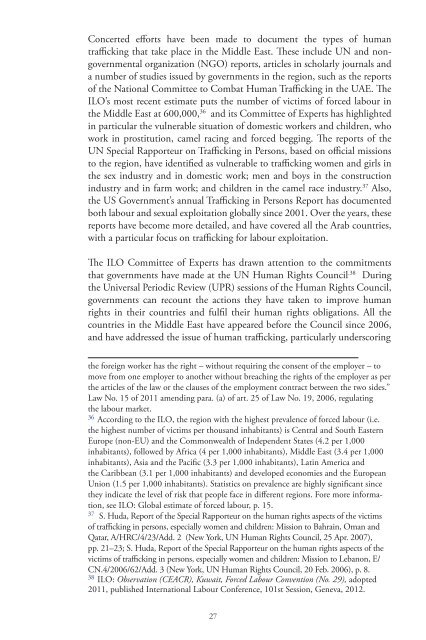Tricked and Trapped: Human Trafficking in the Middle East, ‎pdf 4.1 MB
Tricked and Trapped: Human Trafficking in the Middle East, ‎pdf 4.1 MB
Tricked and Trapped: Human Trafficking in the Middle East, ‎pdf 4.1 MB
You also want an ePaper? Increase the reach of your titles
YUMPU automatically turns print PDFs into web optimized ePapers that Google loves.
Concerted efforts have been made to document <strong>the</strong> types of human<br />
traffick<strong>in</strong>g that take place <strong>in</strong> <strong>the</strong> <strong>Middle</strong> <strong>East</strong>. These <strong>in</strong>clude UN <strong>and</strong> nongovernmental<br />
organization (NGO) reports, articles <strong>in</strong> scholarly journals <strong>and</strong><br />
a number of studies issued by governments <strong>in</strong> <strong>the</strong> region, such as <strong>the</strong> reports<br />
of <strong>the</strong> National Committee to Combat <strong>Human</strong> <strong>Traffick<strong>in</strong>g</strong> <strong>in</strong> <strong>the</strong> UAE. The<br />
ILO’s most recent estimate puts <strong>the</strong> number of victims of forced labour <strong>in</strong><br />
<strong>the</strong> <strong>Middle</strong> <strong>East</strong> at 600,000, 36 <strong>and</strong> its Committee of Experts has highlighted<br />
<strong>in</strong> particular <strong>the</strong> vulnerable situation of domestic workers <strong>and</strong> children, who<br />
work <strong>in</strong> prostitution, camel rac<strong>in</strong>g <strong>and</strong> forced begg<strong>in</strong>g. The reports of <strong>the</strong><br />
UN Special Rapporteur on <strong>Traffick<strong>in</strong>g</strong> <strong>in</strong> Persons, based on official missions<br />
to <strong>the</strong> region, have identified as vulnerable to traffick<strong>in</strong>g women <strong>and</strong> girls <strong>in</strong><br />
<strong>the</strong> sex <strong>in</strong>dustry <strong>and</strong> <strong>in</strong> domestic work; men <strong>and</strong> boys <strong>in</strong> <strong>the</strong> construction<br />
<strong>in</strong>dustry <strong>and</strong> <strong>in</strong> farm work; <strong>and</strong> children <strong>in</strong> <strong>the</strong> camel race <strong>in</strong>dustry. 37 Also,<br />
<strong>the</strong> US Government’s annual <strong>Traffick<strong>in</strong>g</strong> <strong>in</strong> Persons Report has documented<br />
both labour <strong>and</strong> sexual exploitation globally s<strong>in</strong>ce 2001. Over <strong>the</strong> years, <strong>the</strong>se<br />
reports have become more detailed, <strong>and</strong> have covered all <strong>the</strong> Arab countries,<br />
with a particular focus on traffick<strong>in</strong>g for labour exploitation.<br />
The ILO Committee of Experts has drawn attention to <strong>the</strong> commitments<br />
that governments have made at <strong>the</strong> UN <strong>Human</strong> Rights Council .38 Dur<strong>in</strong>g<br />
<strong>the</strong> Universal Periodic Review (UPR) sessions of <strong>the</strong> <strong>Human</strong> Rights Council,<br />
governments can recount <strong>the</strong> actions <strong>the</strong>y have taken to improve human<br />
rights <strong>in</strong> <strong>the</strong>ir countries <strong>and</strong> fulfil <strong>the</strong>ir human rights obligations. All <strong>the</strong><br />
countries <strong>in</strong> <strong>the</strong> <strong>Middle</strong> <strong>East</strong> have appeared before <strong>the</strong> Council s<strong>in</strong>ce 2006,<br />
<strong>and</strong> have addressed <strong>the</strong> issue of human traffick<strong>in</strong>g, particularly underscor<strong>in</strong>g<br />
<strong>the</strong> foreign worker has <strong>the</strong> right – without requir<strong>in</strong>g <strong>the</strong> consent of <strong>the</strong> employer – to<br />
move from one employer to ano<strong>the</strong>r without breach<strong>in</strong>g <strong>the</strong> rights of <strong>the</strong> employer as per<br />
<strong>the</strong> articles of <strong>the</strong> law or <strong>the</strong> clauses of <strong>the</strong> employment contract between <strong>the</strong> two sides.”<br />
Law No. 15 of 2011 amend<strong>in</strong>g para. (a) of art. 25 of Law No. 19, 2006, regulat<strong>in</strong>g<br />
<strong>the</strong> labour market.<br />
36<br />
Accord<strong>in</strong>g to <strong>the</strong> ILO, <strong>the</strong> region with <strong>the</strong> highest prevalence of forced labour (i.e.<br />
<strong>the</strong> highest number of victims per thous<strong>and</strong> <strong>in</strong>habitants) is Central <strong>and</strong> South <strong>East</strong>ern<br />
Europe (non-EU) <strong>and</strong> <strong>the</strong> Commonwealth of Independent States (4.2 per 1,000<br />
<strong>in</strong>habitants), followed by Africa (4 per 1,000 <strong>in</strong>habitants), <strong>Middle</strong> <strong>East</strong> (3.4 per 1,000<br />
<strong>in</strong>habitants), Asia <strong>and</strong> <strong>the</strong> Pacific (3.3 per 1,000 <strong>in</strong>habitants), Lat<strong>in</strong> America <strong>and</strong><br />
<strong>the</strong> Caribbean (3.1 per 1,000 <strong>in</strong>habitants) <strong>and</strong> developed economies <strong>and</strong> <strong>the</strong> European<br />
Union (1.5 per 1,000 <strong>in</strong>habitants). Statistics on prevalence are highly significant s<strong>in</strong>ce<br />
<strong>the</strong>y <strong>in</strong>dicate <strong>the</strong> level of risk that people face <strong>in</strong> different regions. Fore more <strong>in</strong>formation,<br />
see ILO: Global estimate of forced labour, p. 15.<br />
37<br />
S. Huda, Report of <strong>the</strong> Special Rapporteur on <strong>the</strong> human rights aspects of <strong>the</strong> victims<br />
of traffick<strong>in</strong>g <strong>in</strong> persons, especially women <strong>and</strong> children: Mission to Bahra<strong>in</strong>, Oman <strong>and</strong><br />
Qatar, A/HRC/4/23/Add. 2 (New York, UN <strong>Human</strong> Rights Council, 25 Apr. 2007),<br />
pp. 21–23; S. Huda, Report of <strong>the</strong> Special Rapporteur on <strong>the</strong> human rights aspects of <strong>the</strong><br />
victims of traffick<strong>in</strong>g <strong>in</strong> persons, especially women <strong>and</strong> children: Mission to Lebanon, E/<br />
CN.4/2006/62/Add. 3 (New York, UN <strong>Human</strong> Rights Council, 20 Feb. 2006), p. 8.<br />
38<br />
ILO: Observation (CEACR), Kuwait, Forced Labour Convention (No. 29), adopted<br />
2011, published International Labour Conference, 101st Session, Geneva, 2012.<br />
27
















